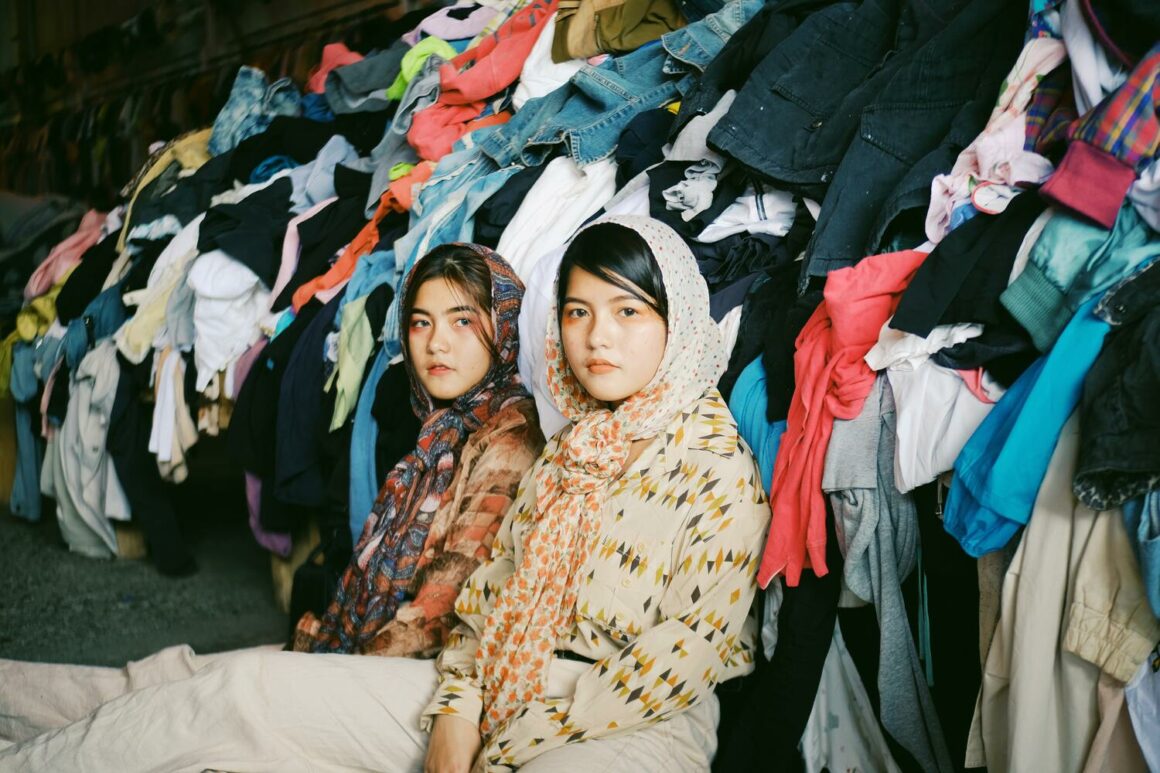Table of Contents
This article contains affiliate links for which I may receive a small commission, at no additional cost to you, should you decide to make a purchase by using them. Learn More
Chances are, you have heard about fast fashion quite a lot. Be it in the news, articles, or from your favorite minimalist YouTubers! Even though this term has been used very frequently in the past three decades, we have only started to be aware of its long-lasting effects on our world.

To the average customer, fast fashion means getting the newest fashion trends at a budget-friendly cost.
That sounds quite useful, right?
While it does seem to do wonders for the fashionistas who cannot afford luxury brands, fast fashion does do more bad than good, as we will soon learn. This industry alone has been responsible for accelerating climate change, keeping workers underpaid, abusing animals for profit, and much more.
Let us guide you through the dark side of fast fashion – from past to present.
What Is Fast Fashion?
The term “fast fashion” was coined by the New York Times in 1989 when Zara first came to New York. They used it to describe how the brand Zara has a mission to bring a garment from the designing phase to the store within 15 days.
Upon hearing it for the first time, one can easily correlate “fast fashion” to efficiency. However, in reality, the fast-fashion definition has more to do with providing trendy clothing items or accessories at surprisingly low price points.

It is a way for the average person to include items of the latest fashion trends in their closet without breaking the bank. That is why fast fashion stores constantly bring in new products according to the changing consumer demands.
Usually, once a celebrity is seen wearing something from high-fashion luxury brands, or when a designer piece from the catwalk gains popularity among fashion enthusiasts, a fast-fashion brand starts producing its replica right away.

As a result, the customers get to order it soon after from their brand-specific e-commerce websites at a fraction of the original’s price. This is where the “fast” from “fast fashion” comes from. The industry wastes no time bringing fashionable clothes and accessories to the palm of your hands at an affordable cost.
Sounds too good to be true, doesn’t it? That’s because it is!
How Did Fast Fashion Start?
Even though fast fashion and its dangers have become mainstream in the last couple of decades, the industry has been here for a long time.

When the European and North American nations were transitioning into the new manufacturing processes through the industrial revolution, the production of fashion items also started to get faster.
Before that time, producing one piece of clothing required tons of time and manual labor. The required materials needed to be sourced, weaved, and then designed by experts. With the revolutionary technology of the 1800s, convenient devices like sewing machines came into play.
As a result, the process of manufacturing clothes and other fashion articles became quicker and easier. This also resulted in their prices going lower and becoming more accessible to the middle class. To make the process even faster and cheaper, sweatshops were created, and workers were recruited at a low wage.
Even though a garment factory disaster occurred in 1911, killing 146 workers, the industry kept growing. After decades, fast fashion started to gain popularity in the 1990s, and the current giants of the industry boosted it even further.
What Is The Problem With Fast Fashion?
Well, it is hard to pinpoint one problem with today’s fast fashion. How about we go through each of the drastically devastating effects caused by this industry to our planet, its animals, and ourselves?
Impact on Environment
Greenhouse Gases
Greenhouse gases are one of the most significant contributors to climate change since they trap heat in the atmosphere and cause respiratory diseases. These gases make the greenhouse effect worse by absorbing infrared radiation. The most notorious of this bunch are carbon-di-oxide and methane.
As Princeton Student Climate Initiative (PSCI) reported in 2020, the fast fashion industry alone is now producing higher carbon emissions per year than all international flights and maritime shipping combined. If it refuses to change its ways, we will see a 50% increase in these emissions within the next ten years!

This happens because fast fashion consumes a considerable amount of energy to manufacture and transport millions of garments each year. In fact, H&M outs out 12-16 collections per year while Zara puts out 24, according to Business Insider.
They are produced in countries like Bangladesh, India, and China, where coal is the primary fuel for power plants. Even many of their dresses use synthetic fibers, which itself has been made from fossil fuels.
Water Usage And Wastage
Mass production of fast fashion items leads to toxic wastewater, which often goes untreated. For instance, 22,000 tons of wastewater from local tanneries is dumped directly into the Buriganga river of Bangladesh every year!
Chemicals in this waste like arsenic, mercury, and lead pose a grave danger to both wildlife and humans living close to those water bodies. When it runs into the sea, it also pollutes the aquatic creatures living there.
Additionally, a lot of water is wasted in production, leading to water scarcity. For instance, even though cotton is a natural fabric, cultivating just 1 kg of it requires up to 20,000 liters of water! Making one cotton shirt uses up 713 gallons of water!
Deforestation
Trees and soil are an integral part of our planet, which naturally helps us minimize our overall carbon footprint. That is why forests can contribute to global warming prevention by absorbing carbon dioxide in large amounts.
Fast fashion threatens that system by demanding more animal-based materials like wool. These animals like goats and sheep tend to overgraze pastures which then causes soil erosion, loss of plant species, and food shortages.
Chemicals used to produce cotton, and wood-based fibers like rayon also add to mass deforestation.
Toxins and Microfibers
Since fast fashion is all about keeping costs low and profits high, they often use cheap synthetic fabrics like nylon and polyester. When you wash them (not only the first time, every time), these fabrics will release around 700,000 microfibers. Once they reach wastewater and then eventually the ocean, aquatic creatures die after ingesting them.
Many other toxins like this are released into the environment in several stages of textile production. Greenpeace Detox specified 11 such chemicals related to clothes production, which can cause cancer and hormonal dysfunctions.
Impact on Workers
You would think the people putting in their efforts and hours for producing such popular items would get their dues. Unfortunately, they are deprived of that well-deserved right. On top of that, they are made to work in inhumane conditions to reduce the labor cost even further.

As a result of their negligence and greed, the garment factory of Bangladesh called Rana Plaza collapsed in 2013, killing over a thousand laborers. Fast fashion brands like Mango and Benetton denied responsibility for this even though the deceased workers were making clothes for them in that factory.
Moreover, during the Covid-19 pandemic of 2020, they suffered from zero pay when the factories were closed in lockdown since their wage was too low, to begin with. Many brands canceled their orders which made over 10,000 workers lose their jobs within this timeframe.
This industry is also notorious for exploiting skilled laborers without paying any heed to their fundamental human rights. In May of 2018, Global Labor Justice exposed how gender-based violence has been going on at Asian factories that produce garments for American fast fashion brands like Gap and H&M.
Impact on Animals
Animals suffer from fast fashion manufacturing procedures both directly and indirectly.
It is heartbreaking to learn how animals, including cats and dogs, are abused to obtain real fur for fast fashion products. In the wake of animal rights getting more coverage, many brands now present real fur as faux fur to win both ways – claiming sustainability while keeping costs low.
On the other hand, animals living on land or water are adversely affected due to toxic elements from production entering the waterways. Such harmful elements are either breathed in or ingested and then often passed on through the food chain.
Impact on Consumers
Getting trapped in the rapidly changing trends of fast fashion, consumers also unknowingly harm themselves. The irony lies in how much they buy and how soon they get rid of these products.
Because these brands bring in new collections and designs almost every week, fashion lovers struggle to keep up with the latest trends. Since the new clothes come with a cheap price tag, they can purchase them even more frequently.

This is evident from the 2014 data provided by the combined analysis of UK-based Ellen MacArthur Foundation and the World Economic Forum. It states that people bought 60% more garments compared to 2000.
What’s more astonishing is how 85% of all such textiles go to landfills every year. That is equal to getting rid of a garbage truck of clothes per second! Moreover, from all the used clothing, less than 1% is recycled. The previously mentioned analysis also found that about $500,000 is wasted per year for such barely-worn clothing.
So many of the middle-class fashionistas lose a chunk of their money on clothes that they don’t get to wear long enough, while the overall economy suffers simultaneously. It’s a lose-lose situation either way.
Who Are The Biggest Fast Fashion Brands?
Shein
The Chinese retailer company Shein is one of the biggest fast fashion brands globally, with online stores in other countries like Canada, the USA, and the UK. Even though it is popular among Gen Z and celebrities like Katy Perry, it has been accused of damaging the environment and plagiarizing creations of smaller labels.
They have not taken any measure to resolve these issues or to improve workers’ conditions. The only ethical value they have right now is animal welfare. Most of its products are free of animal skin and fur. However, they do use wool without stating the sources of that material. So it is still a questionable stance to take.
H&M
H&M is such a popular brand that there have been SNL skits and songs on it. However, this fast fashion label failed to keep its promise of paying 850,000 Bangladeshi garment workers a living wage by 2018. In the same year, Global Labour Justice reported their abuse of female garment workers.
The few commendable steps H&M has taken includes:
- Having a recycling program for returned clothes.
- Using renewable energy in its supply chain.
- Following a Canopy-approved policy to prevent deforestation of endangered forests.
H&M has also pledged to lower its greenhouse gas emissions and use 100% sustainable or recycled materials by 2030. Time will tell if they can successfully meet these targets or not.
Zara
One of the most significant sensations in the fast-fashion world – Zara has about 3000 stores across almost a hundred countries. As we previously mentioned, it is known to bring in over 20 collections annually, which increases wastage and harms both humans and the environment.
Its parent company, Index, has taken the initiative called “Closing the loop” to recycle returned clothes, while the brand uses recycled packaging. On the other hand, it has not reduced textile waste and has not gotten any closer to meeting its target of reducing greenhouse gas emissions.
Moreover, its entire business model based on providing new items every 13 days is inherently harmful. So until that basis is altered to a more sustainable one, Zara will continue to be one of the power players in maintaining the current fast fashion fallacies.
What Progress Have We Made So Far?
Going Green
After trying to draw people’s attention to this issue for years, the number of retailers willing to make sustainable changes for ethical fashion has started to increase recently. The common measures for going green include recycling for clothes returned in-store and letting customers discard unwanted items in bins placed at the store.

However, the primary reason behind the dangers of fast fashion – its unusually high production speed – has not been tackled so far. The culture of throwing away clothes after only ten uses is also an unresolved issue.
Raising Awareness
Since the profits of fast fashion lie in the hands of consumers, they will take notice if we raise our voice and start asking, “who made my clothes?” before purchasing anything. Of course, none of us could have a sound sleep at night knowing that the dress we just bought was made by an underpaid laborer or from a tortured animal.

Additionally, you can stay away from brands that still follow the fast fashion mantra. You can spot them by noticing if they have thousands of items on the latest trends, boast about unusually short turnaround time, rely on cheap offshore manufacturing companies, and often use inferior materials like polyester.
Buying Less
Even though many of us want to wear trendy clothes, it would be more beneficial to buy less for the larger good. And when you think about it, minimalism is so much more than just a trend!

Adopting the minimalist philosophy can simultaneously make you fashionable, financially viable, and an ally to the environment, animals, and skilled garment workers from the third world.
That’s why now many conscious people observe “Buy Nothing Day” as a protest against excessive consumerism. On this particular day, individuals are known as “trash queens” who wear recycled clothes and visit stores in Euro-Asia cities to inspire others to buy less.
Sustainable Alternatives
The good news about fast fashion lovers is that many non-fast fashion brands can still get you affordable, trendy items. Additionally, these sustainable brands take the wide range of human figures into account and include options for all sizes.

Some such brands that are not fast fashion include MATE the Label, No Nasties, MUD Jeans, Kowtow, Armedangels, and Mila.Vert.
You can also support small businesses based on online platforms like Etsy, Poshmark, Depop, ThredUP, and Mercari.
Conclusion
Even though the fast fashion industry is still exploiting workers in third-world countries and not being fully transparent about their source of materials, we are making progress with its awareness.
Even a decade ago, most people disregarded its adverse effects since it provided them with benefits. However, in the long run, we have to decide our priorities as a species. Do we care more about looking fashionable, or is survival and well-being of the planet more important to us?











